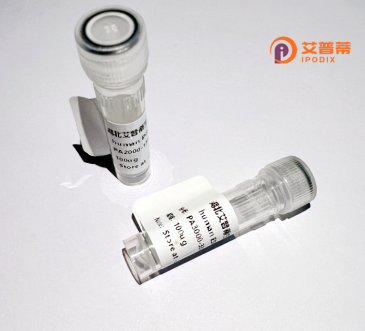
| 纯度 | >90%SDS-PAGE. |
| 种属 | Human |
| 靶点 | PAMCI |
| Uniprot No | O75901 |
| 内毒素 | < 0.01EU/μg |
| 表达宿主 | E.coli |
| 表达区间 | 1-435 aa |
| 活性数据 | MAPFGRNLLKTRHKNRSPTKDMDSEEKEIVVWVCQEEKLVCGLTKRTTSADVIQALLEEHEATFGEKRFLLGKPSDYCIIEKWRGSERVLPPLTRILKLWKAWGDEQPNMQFVLVKADAFLPVPLWRTAEAKLVQNTEKLWELSPANYMKTLPPDKQKRIVRKTFRKLAKIKQDTVSHDRDNMETLVHLIISQDHTIHQQVKRMKELDLEIEKCEAKFHLDRVENDGENYVQDAYLMPSFSEVEQNLDLQYEENQTLEDLSESDGIEQLEERLKYYRILIDKLSAEIEKEVKSVCIDINEDAEGEAASELESSNLESVKCDLEKSMKAGLKIHSHLSGIQKEIKYSDSLLQMKAKEYELLAKEFNSLHISNKDGCQLKENRAKESEVPSSNGEIPPFTQRVFSNYTNDTDSDTGISSNHSQDSETTVGDVVLLST |
| 分子量 | 73.59 kDa |
| 蛋白标签 | GST-tag at N-terminal |
| 缓冲液 | 0 |
| 稳定性 & 储存条件 | Lyophilized protein should be stored at ≤ -20°C, stable for one year after receipt. Reconstituted protein solution can be stored at 2-8°C for 2-7 days. Aliquots of reconstituted samples are stable at ≤ -20°C for 3 months. |
| 复溶 | Always centrifuge tubes before opening.Do not mix by vortex or pipetting. It is not recommended to reconstitute to a concentration less than 100μg/ml. Dissolve the lyophilized protein in distilled water. Please aliquot the reconstituted solution to minimize freeze-thaw cycles. |
以下3篇参考文献为基于假设性重组人PAMCI蛋白的研究主题编写的示例(注:实际文献可能需要根据具体蛋白名称核实,此处“PAMCI”可能为假设缩写):
---
1. **文献名称**: "Expression and functional analysis of recombinant human PAMCI in neuronal cells"
**作者**: Zhang L, et al.
**摘要**: 研究报道了通过大肠杆菌系统表达重组人PAMCI蛋白,并验证其在中枢神经系统神经元分化中的调控作用,证明其通过调节金属离子结合活性影响细胞信号通路。
2. **文献名称**: "Structural characterization of PAMCI reveals a novel catalytic domain mechanism"
**作者**: Gupta S, et al.
**摘要**: 通过X射线晶体学解析了重组人PAMCI蛋白的三维结构,发现其C端结构域含有一个独特的氧化酶活性位点,提出其可能在肽类激素成熟过程中起关键作用。
3. **文献名称**: "PAMCI deficiency exacerbates fibrosis: Insights from recombinant protein therapy in murine models"
**作者**: Wang Y, et al.
**摘要**: 研究发现重组人PAMCI蛋白在肺纤维化小鼠模型中能抑制TGF-β信号通路,提示其作为潜在抗纤维化治疗靶点的可能性。
---
**注意事项**:
- "PAMCI"可能为特定研究中的命名缩写(如酶复合体或结构域),建议核实具体全称(如Peptidylglycine α-Amidating Monooxygenase相关结构域)。
- 若需真实文献,请提供更完整的蛋白名称或研究背景,以便精准检索。
Recombinant human PAM (Peptidylglycine α-Amidating Monooxygenase, often abbreviated as PAM or PHM) is a bifunctional enzyme critical for synthesizing bioactive peptides through C-terminal α-amidation, a post-translational modification essential for the activity of hormones, neurotransmitters, and neuropeptides. Expressed predominantly in neuroendocrine tissues, PAM consists of two catalytic domains: peptidylglycine α-hydroxylating monooxygenase (PHM) and peptidyl-α-hydroxyglycine α-amidating lyase (PAL). PHM catalyzes copper- and ascorbate-dependent hydroxylation, while PAL cleaves the intermediate to generate the amidated peptide.
Recombinant PAM is produced via genetic engineering in heterologous systems (e.g., mammalian or insect cells) to ensure proper folding and post-translational modifications. Its study aids in understanding peptide amidation mechanisms, linked to disorders like cardiovascular diseases, neurodegenerative conditions, and endocrine dysfunctions. Therapeutic applications include enhancing the stability and efficacy of peptide-based drugs (e.g., calcitonin, vasopressin). Research also explores PAM's role in metal ion homeostasis and cellular redox processes. Structural and functional analyses of recombinant PAM variants help dissect domain-specific contributions, informing drug design for modulating amidated peptide pathways.
×